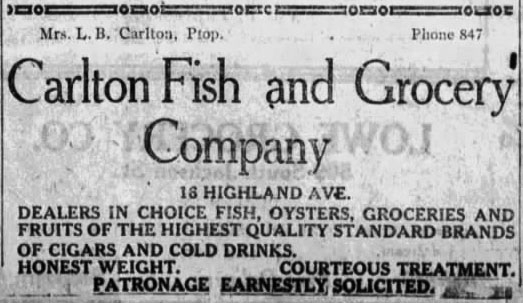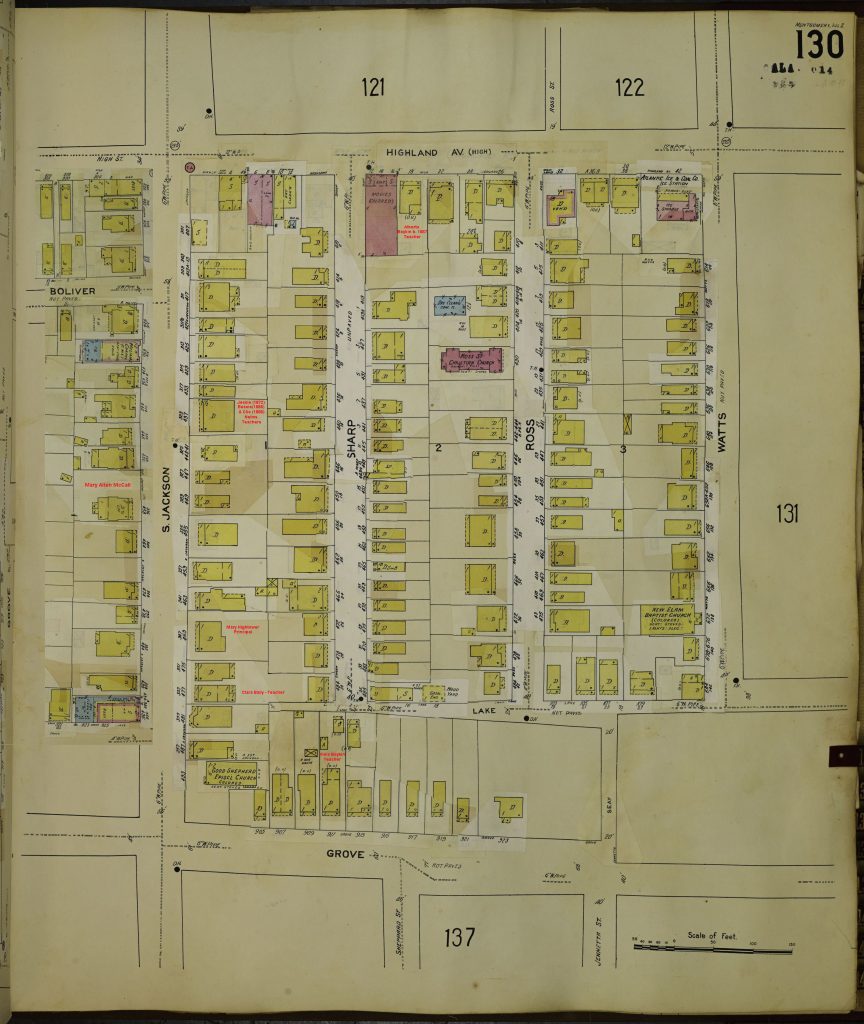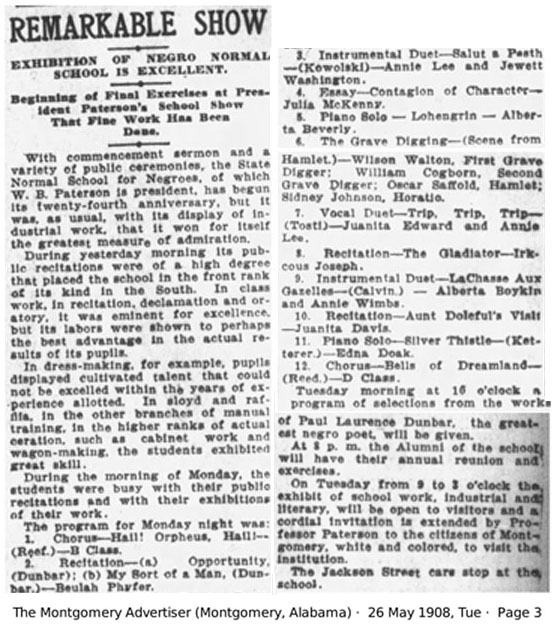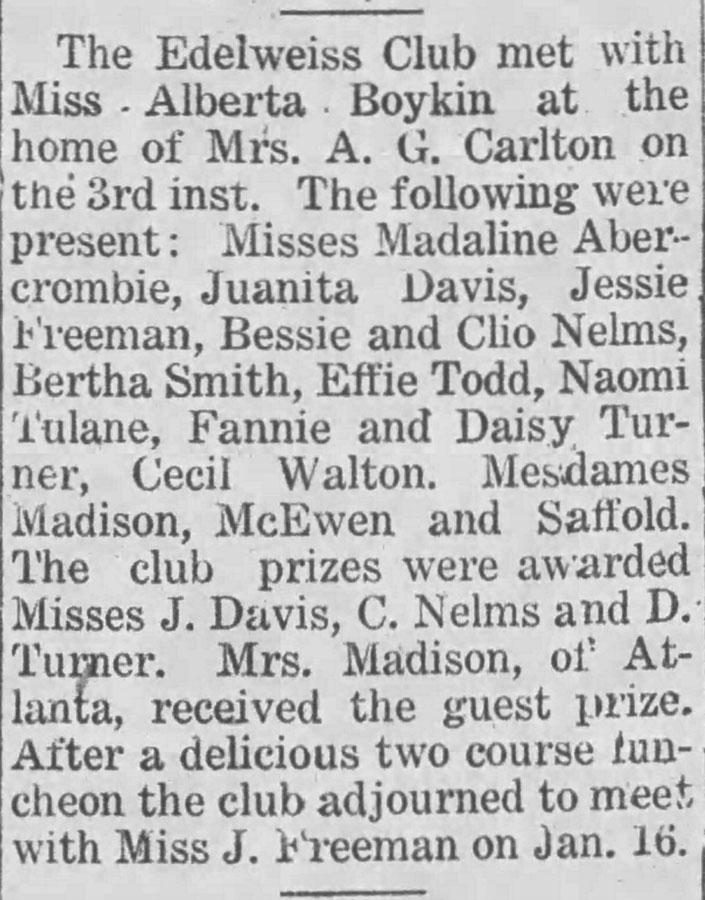In 2018 I did a series of posts for the A to Z Challenge based on articles taken from The Emancipator, an African American newspaper published in Montgomery Alabama from 1917 – 1921. I mentioned the Edelweiss Club in several posts. There were 37 young women who attended the club meetings. They were friends and neighbors of my grandmother Fannie Mae Turner Graham.
In 2021 I planned to present snapshots from the lives of some of those women as my A to Z theme. I decided not to complete the challenge that year so only completed two biographies. This is the second one.
Alberta Boykin was born in Alabama about 1893, the second and youngest child of Charles and Texanna (Thomas) Boykin. Her older sister, Wilhelmina had been born three years earlier in Florida. The girls never appeared in a census with their parents who presumably died before 1900, when we find Alberta living with her mother’s sister Sarah. I could not find Wilhemina in the 1900 census but did find her in the 1910 census living with her uncle William Boykin, her father’s brother in Camden, South Carolina. Their father had been born in Camden. Her mother was born in Montgomery, Alabama.
_______________
In 1900 Alberta was seven years old and lived with her mother’s sister, Sarah Thomas Wright. Sarah Wright was 40 and divorced from her former husband, John Wright. John Wright later married my great grandmother Jennie Allen Turner, as her second husband. That marriage also ended in divorce. Sarah Wright had no birthed children but three of her nieces lived with her. In addition to Alberta, there were the Barnett sisters Lillie, age 15 and Sadie who was 14, daughters of her sister Ellen Thomas and Frank Barnett. All of the girls attended school. Sarah owned her home, which was mortgaged. She taught at the State Normal School.
In 1908 Alberta graduated from State Normal School for Negroes. She was 15. She played Wagner’s Lohengren on the piano for her part in the program.
Remarkable Show
Exhibition of Negro Normal School is Excellent.
Beginning of Final Exercises at President Paterson’s School Show That Fine Work has been done.
With commencement sermon and a variety of public ceremonies, the State Normal School for Negroes of which W. B. Paterson is president has begun it’s twenty-fourth anniversary, but it was, as usual, with its display of industrial work, that it won for itself the greatest measure of admiration.
During yesterday morning its public recitations were of a high degree that placed the school in the front rank of its kind in the South. In class work, in recitation, declamation and oratory, it was eminent for excellence, but its labors were shown to perhaps the best advantage in the actual results of its pupils…
The program for Monday night was:… Instrumental Duet – LaChasse Aux Gazelles—(Calvin.) – Alberta Boykin and Annie Wimbs…
Tuesday morning at 10 o’clock a program of selections from the works of Paul Laurence Dunbar, the greatest negro poet, will be given.
At 3 p. m. the Alumni of the school will have their annual reunion and exercises.
On Tuesday from 9 to 3 o’clock the exhibit of school work, industrial and literary, will be open to visitors and a cordial invitation is extended by Professor Paterson to the citizens of Montgomery, white and colored, to visit the institution.
The Jackson Street cars stop at the school.
In 1914 at age 21 Alberta was in Columbia, South Carolina attending and teaching at Benedict College

Benedict College is a private historically black, liberal arts college in Columbia, South Carolina. Founded in 1870 by northern Baptists, it was originally a teachers’ college. It has since expanded to offer majors in many disciplines across the liberal arts. Wikipedia
Benedict College, Columbia, South Carolina, Forty-Third Year _ Faculty for the year 1914-1915….
Normal Practice School (Consisting of Primer Class and First Five Grades) Miss J. Alberta Boykin, L. I., A. B. Assistant
Courses
Benedict College offers instruction in the following:
College- four years’ course, leading to A. B. or B. S. Large place is given to the sciences. The laboratories are modern.
Normal- four years’ course, leading to the degree of L. 1 Practice school in connection furnishes two years’ experience in teaching. The practice teaching is required in the third and fourth years. Experiments performed in the laboratory by students under direction of competent instructor.
On January 3rd 1919, The Edelweiss Club was hosted by Alberta Boykin at the home of her cousin, Lillian Barnett Carleton. She was living there in the 1920 Census and probably when the meeting was held. There were quite a few members and guests in attendance. I wish I knew what the delicious two course meal consisted of.
Weather forecast for the day of the Edelweise meeting.
For Montgomery and Vicinity – Rain this afternoon probably changing to snow flurries, followed by clearing during tonight. Colder tonight, with lowest temperature about 26 to 28 degrees. Thursday, fair and cold. Fresh northerly winds.
In 1920 Census, 27 year old Alberta Boykin was listed as a lodger in her cousin, Lillie Barnett Carlton’s home. Albert Carlton was listed as the head. He was 33 and owned his home, with a mortgage, at 18 Highland Ave. He was a mail carrier for the city. Lillie was 32 and a grocery sales lady. She was actually the proprietor of the Carlton Fish and Grocery Company, which was located next to her home at 16 Highland.

Alberta was 24 and taught at the Normal School. There was another lodger, Lula M. Johnson who taught at the Normal School.

I cannot find anything about Alberta Boykin after her marriage in 1920. On December 27, 1920, Juliette Alberta Boykin married Richard Brooks. Her ending is a mystery, as was her beginning.
________________
I found this information at Newspapers.com, Census records on Ancestry, and other places on the internet.
Other Posts about the Edelweiss Club
Xmas Edelweiss Club Meeting
A to Z Challenge Theme REVEAL – 2021
Members of the Edelweiss Club (Part 1)
Mapping Montgomery (Part 2)
Madeline Abercrombie
Can’t Continue!


I liked the piano piece. I hope a descendant of Alberta finds this post and can fill in what happens next.
That would be nice. I have been reached out to by descendants of other of the women. Usually they are looking for more information because they are great grandchildren with little information. I do enjoy when that happens.
This series will be invaluable to descendants of the Edelweiss Club members. The first two women you have written about sound fascinating. The club seems to have provided social networking as well as professional support to these remarkable women. Look forward to learning more.
It seems to be mostly social with whist played and delicious refreshments served. Probable a welcome relief from the weeks work.
I strained to read the whole newspaper article and then found you’d transcribed it for your readers’ benefit! I wonder if Alberta ever met her brother who went to live with an uncle when she was sent to her aunt’s? She was an accomplished and well-educated young woman. I wonder if she was considered too old to marry or whether she married and moved far away somewhere with her husband–up North? How could you track her down then?
Something that I was reminded of is that, like today, people divorced and remarried, had blended families and lived with relatives. After her parents died, Alberta lived first with an aunt, then with a married cousin. Perhaps extended family members extended a welcome to each other more than they tend to do nowadays. Or perhaps, as then, it differed by class and region.
Sorry about that! I’ve added a line that they are transcribed, also made all so they will enlarge.
Alberta spent time in South Carolina and people were always visiting back and forth and traveling so I am sure the sisters did see each other.
The members of the Edelweiss Club who married were usually in their late 20s or older, so she wasn’t too old when she disappeared. Other women did seem to disappear but I found them living in other states with siblings when I looked at their households. On Ancestry I can do a search all over the country for people and find them marrying in another state. Or they show up on their children’s social security applications and death certificates. I’ll check on her later and perhaps she will show up.
Sounds like a very capable young lady! I want to believe she lived happily under another name. 🙂
Welcome back to A to Z! Always lovely to read your posts 🙂
The Multicolored Diary
I am running so fast to try to stay current! More like treading water to avoid sinking! I’m afraid she died, but I’ve been wrong before 🙂
I enjoyed reading your profile of Alberta who rose from the early death of her parents to become a talented pianist and admirable young woman. I hope you are able to find out about her later life.
Alberta sounds like a capable and talented woman. My grandfathers were both born in the 1890’s so contemporaries of hers. Alas, neither of them played anything 🙂
As usual, the meticulousness of your research blows my mind, every time.